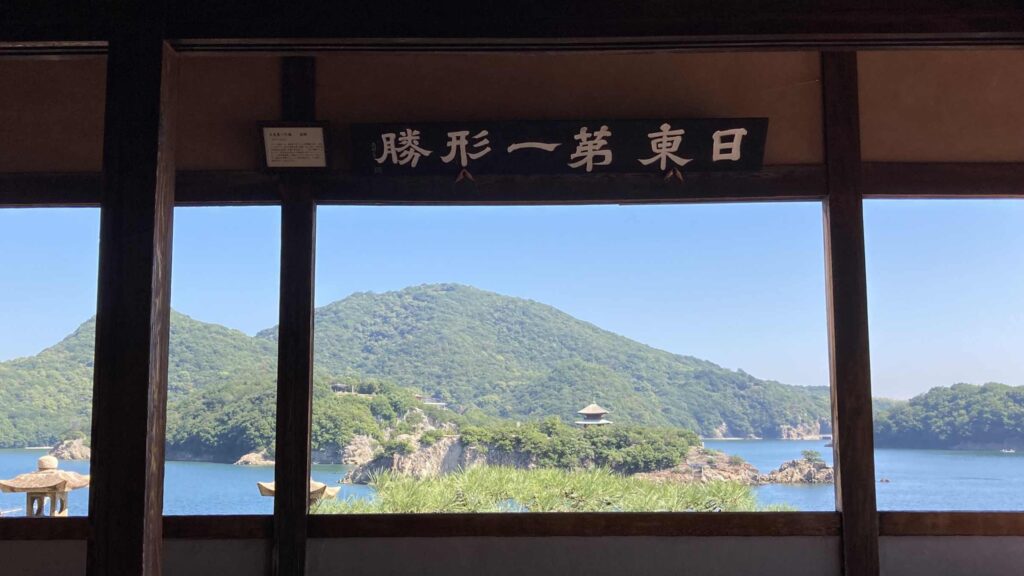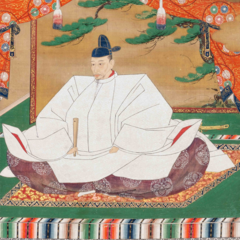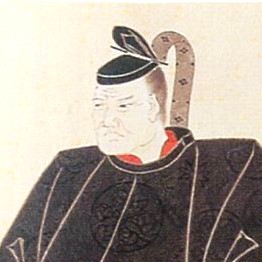Taichoro, The Most Beautiful Guest Room Admired by the Korean Envoy
The view from Taichoro at Fukuzen-ji Temple, a reception hall and the guest lodge for the Korean Envoy, is a dignified beauty like a picturesque landscape framed by wooden columns. This scenic vista extends to the Sensuijima and Benten-jima islands in the east, while the Shikoku Mountains are in the distance, overlooking the Seto Inland Sea. An officer from the 8th Envoy, Bangeon Lee, praised its beauty, hailing it as “The most beautiful scenic area in Japan (日東第一形勝).” Taichoro stands as a symbol of the warm relationship fostered through the collective efforts of numerous policymakers.

The First Step Toward Building a Relationship Destroyed by Korean Invasions


Tokugawa Ieyasu (1543-1616, 徳川家康) aimed to restore relations with Korea, the Ming Dynasty, and various Southeast Asian nations, which had suffered due to Toyotomi Hideyoshi's (1537~1598, 豊臣秀吉) invasions of Korea in 1592-93 and 1597-98. Ieyasu possessed considerable knowledge of diverse overseas affairs at that time from Jan Joosten, who had voyaged on the Dutch ship Liefde, and William Adams from England. He sought to establish international diplomacy and restore these disrupted connections. The letter addressed to the Korean king expressed Japan’s desire for diplomatic relations founded on mutual trust and honor, devoid of any desire for dominance over Korea or seeking advantages. This approach did not ease Korea’s apprehensions by return. Korean Emissary came to Japan and met with Ieyasu to ascertain whether or not Japan was willing to make peace. It helped the meeting that Ieyasu had not dispatched troops to Korea during the invasions. Consequently, the Korean Dynasty initiated diplomatic discussions, aiming for the repatriation of around 50,000 or more Koreans whom Hideyoshi’s forces had taken.
Following persistent efforts from both sides, especially from the Tsushima domain, an agreement was reached to send a Korean envoy to Edo in 1607. The official purpose was i) responding to the Japanese invitation, ii) observation of the internal Japanese political situation, and iii) repatriation of prisoners. These envoys had an audience with the 2nd Shogun, Hidetada. The meeting was fruitful, culminating in an agreement to facilitate the return of Korean individuals to their homeland. The initial envoy mission successfully repatriated 1418 people to Korea. During their return, they met with Ieyasu at Sunpu Castle in Shizuoka Prefecture.
Fostering Bilateral Exchanges Signified the Intent to Build a Positive Relationship
The fourth envoy focused on fostering bilateral exchanges. This led to the renaming of the envoys as “Tsushin-shi (通信使)”, signifying the intent to build a positive relationship. Following this, both nations deepened their amicable ties as neighboring countries, engaging in twelve Emissaries to celebrate the inauguration of the new Tokugawa shogun until 1811.
The Envoy’s Voyage from Hanseong to Edo

朝鮮通信船上関来航図 (Source: 宗教法人 超専寺)
The Envoy’s voyage from the Korean capital, Hanseong known as Hanyang (now Soul), to Edo spanned approximately a year. They traveled five or six ships carrying around 450 Korean individuals abroad and navigated through the Genkainada Sea to reach Kyushu. Upon reaching the northern shores of Kyushu, the Fukuoka domain warmly hosted the Envoy with 500 courtesy boats escorting them to Ainoshima Island in Hakata Bay. There, the Envoys were graciously hosted in 24 newly constructed accommodation facilities with various exquisite dishes, enjoying several days of hospitality. Navigating through the Kanmon Straits into the Set Inland Sea through Kaminoseki, the envoy’s ships were guided by approximately 1000 skilled watermen from the Murakami Navy. These experts read wind and tide patterns, ensuring the safe passage of the envoy’s ships as they swiftly sailed toward Osaka Bay.

During their journey, the Envoy stayed at Taichoro, where the Fukuyama domain graciously welcomed them. During their stay in Taidhoro (對潮樓), cultural exchanges proceeded between the Korean delegation and the neighboring academic person. Notably, the envoy comprised numerous erudite individuals including scholars, artists, poets, and medical scholars.

Continuing their voyage, upon reaching Osaka Bay, they transitioned to smaller Japanese river boats to ascend the Yodo River, guided by the flotilla from the Tsushima domain. Several boats such as Kiikunimaru carrying Korean letters, Tosamaru accommodating a senior envoy, Naka-Tosamaru with a vice-envoy, Naniwamaru with an officer, and others sailed along this route. Their arrival was met with an enthusiastic and warm welcome from the local people.
Arriving at Edo through Kyoto and Nagoya, and traversing the Hakone steep mountains, the envoys were met with a rapturous welcome from countless Edo residents lining the streets, receiving a heartful welcome from the Tokugawa Shogunate. Senior envoys engaged in meetings at Edo Castle with Shogun, Tokugawa Hidetada, where they received a message and reached an agreement to facilitate the return of numerous Korean individuals to their homeland. Meanwhile, Tokugawa’s envoy journeyed to Korea, endeavoring to foster a positive relationship. They stayed at a newly constructed Japanese-style accommodation in Busan. However, they were unable to visit Hanson due to Koreans’ lingering wariness stemming from Hideyoshi’s past invasions.
Designated as the UNESCO Memory of Korea
Through the collaborative efforts of many parties between Japan and South Korea, in 2017, 'The History of Peace Building and Cultural Exchanges between Korea and Japan from the 17th to 19th Century,' was designated as a UNESCO Memory of Korea. The application states, "It is a peaceful and intellectual heritage backed by the historical experiences of both nations and it holds exceptional and universal value, offering solutions to global challenges fostering enduring peaceful relations and respect for diverse cultures." In 2023, after a hiatus of four years due to COVID-19, the celebrated Korean Emissary parade, resumed in Busan, Tsushima, and some cities. The procession featured numerous participants dressed in traditional costumes. Take pleasure in watching the parade, a testament to extensive endeavors aimed at reinstating diplomatic relations between these two countries. We also invite you to enjoy the spectacular view of the Seto Inland Sea at Taichoro of Fukuzen-ji Temple while thinking about the collective efforts of the two countries that deepened the friendship.
Korean Envoy Timeline
| 1585 | Hideyoshi became Kanpaku (chief advisor to the Emperor) |
| 1586 | Hideyoshi built the huge Osaka castle |
| 1590 | Hideyoshi unified the nation |
| 1590 | Ieyasu moved to Edo according to Hideyoshi's order |
| 1592 | Bunroku war, Hideyoshi's invasion of Korea |
| 1597 | Keicho war, Hideyoshi's invasion of Korea |
| 1598 | Hideyoshi passed away |
| 1600 | Tokugawa Ieyasu defeated Ishida Mitsunari, Hideyoshi's right arm at the battle of Sekigahara |
| 1603 | Tokugawa Ieyasu established Tokugawa Shogunate at Edo |
| 1604 | Korean Emissary met with Ieyasu to ascertain whether or not Japan was willing to make peace |
| 1607 | The first Korean envoy came to Edo and met the 2nd Shogun, Hidetada (467 envoys). (Korean 14th King Seonjo) |
| 1615 | Toyotomi's Osaka Castle burnt down to the ground at the Summer Siege of Osaka |
| 1616 | Ieyasu passed away at the age of 75 |
| 1617 | 2nd Korean Envoy (428) met 2nd Shogun, Hidetada (15th King Gwanghaegun of the Joseon dynasty of Korea) |
| 1624 | 3rd Korean Envoy (300) met 3rd Shogun, Iemistu (16th King Injo) |
| 1636 | 4th Korean Envoy (475) met 3rd Shogun, Iemistu (16th King Injo) |
| 1643 | 5th Korean Envoy (462) met 3rd Shogun, Iemistu (16th King Injo) |
| 1655 | 6th Korean Envoy (488) met 4th Shogun, Ieysuna (17th King Hyojong) |
| 1682 | 7th Korean Envoy (475) met 5th Shogun, Tsunayoshi (19th King Sejong) |
| 1711 | 8th Korean Envoy (500) met 6th Shogun, Ienobu (19th King Sejong) |
| 1719 | 9th Korean Envoy (479) met 7th Shogun, Yoshimune (19th King Sejong) |
| 1748 | 10th Korean Envoy (475) met 8th Shogun, Ieshige (21st King Yeongjo) |
| 1764 | 11th Korean Envoy (472) met 9th Shogun, Ieharu (21st King Yeongjo) |
| 1811 | 12th Korean Envoy (336) met 10th Shogun, Ienari (23rd King Seonjo) |
Recommendations to visit
- Access: 1 hour from JR Shin Osaka Station or 25 minutes from JR Hiroshima Station on Sanyo Shinkansen. Take the Tomotetsu bus at JR Fukuyama Station South Exit. Get off at the "Tomoko (鞆港)" bus stop, then a 5-minute walk.


